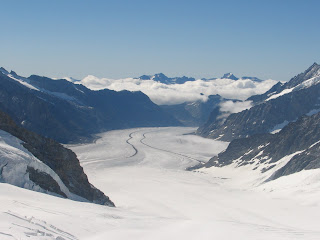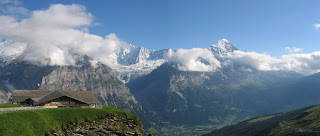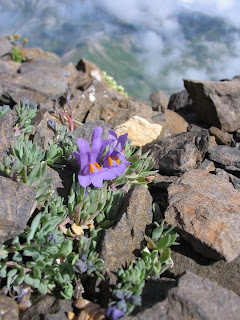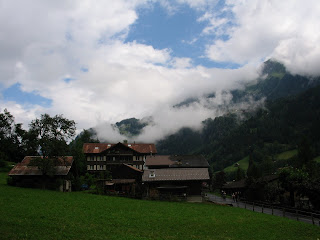 On Tuesday morning we awoke to relatively clear skies and a bit of mist in the village, not unlike that of the day before, so we figured that the weather would be much like that on Monday. We therefore decided to do another walk, this time from the small village of Wengen up the side of the Lauterbrunnen valley to Maenlichen. Walk is probably not entirely the right word - prolonged, steep climb is more appropriate, with an
On Tuesday morning we awoke to relatively clear skies and a bit of mist in the village, not unlike that of the day before, so we figured that the weather would be much like that on Monday. We therefore decided to do another walk, this time from the small village of Wengen up the side of the Lauterbrunnen valley to Maenlichen. Walk is probably not entirely the right word - prolonged, steep climb is more appropriate, with an  altitude increase of about 1km but barely any horizontal displacement. By the time we had taken the train to Wengen, the fine morning weather had become more menacing, with thick grey clouds above us. More ominous still were the few drops of moisture that appeared to come from above. Perhaps a little pumped from the day before, we decided to keep on going, even when the few drops of moisture turned into a moderately-light rain.
altitude increase of about 1km but barely any horizontal displacement. By the time we had taken the train to Wengen, the fine morning weather had become more menacing, with thick grey clouds above us. More ominous still were the few drops of moisture that appeared to come from above. Perhaps a little pumped from the day before, we decided to keep on going, even when the few drops of moisture turned into a moderately-light rain. After about an hour's climb, the treeline gave way to mountain meadow, but the gradient was now pretty intense and the rain showed no sign of stopping. On a fine day this part of the walk would undoubtedly have been spectacular, but the thick clouds lying in the valley obscured the view, so we pushed on. In any case, we were now only interested in reaching the top to get out of the
After about an hour's climb, the treeline gave way to mountain meadow, but the gradient was now pretty intense and the rain showed no sign of stopping. On a fine day this part of the walk would undoubtedly have been spectacular, but the thick clouds lying in the valley obscured the view, so we pushed on. In any case, we were now only interested in reaching the top to get out of the rain. When we finally got there I was soaking. Although I had worn my water-proof jacket, the rain rolling down my neck was enough to drench me. Which would have been OK, were it not for the fact that it was not at all warm at Maenlichen, and I wasn't keen on hypothermia. Maenlichen itself is not so much a town as a restaurant, a gondola station and a cable car stop. Making the obvious choice, we headed for the restaurant and warmth. Despite the signs of "No Picnic" in the restaurant, we found ourselves a little out-of-the-way table at which to eat our packed lunch. We also bought a cup of coffee and a cake to distract attention from our sandwiches. We probably shouldn't have bothered - the staff looked pretty bored actually, and we were able to sit there for a few hours as it rained outside.
rain. When we finally got there I was soaking. Although I had worn my water-proof jacket, the rain rolling down my neck was enough to drench me. Which would have been OK, were it not for the fact that it was not at all warm at Maenlichen, and I wasn't keen on hypothermia. Maenlichen itself is not so much a town as a restaurant, a gondola station and a cable car stop. Making the obvious choice, we headed for the restaurant and warmth. Despite the signs of "No Picnic" in the restaurant, we found ourselves a little out-of-the-way table at which to eat our packed lunch. We also bought a cup of coffee and a cake to distract attention from our sandwiches. We probably shouldn't have bothered - the staff looked pretty bored actually, and we were able to sit there for a few hours as it rained outside. After a little bit it seemed to fine up outside. Since I was soaking, Shev lent me his backup shirt and after a final hot chocolate (we became addicted to chocolate during our time in Switzerland) we decided to venture outside to see what we could of the view. Although I couldn't clearly make out most of the valley, the view down to Wengen was nevertheless dizzying (left, yes, that is looking down), and I think we were a little surprised to see just how far we had managed to come. I convinced Shev that we should go to Maenlichen peak, just a short walk from the restaurant. Our first attempt ended with a return of the rain, which sent us scurrying back inside he restaurant. A little
After a little bit it seemed to fine up outside. Since I was soaking, Shev lent me his backup shirt and after a final hot chocolate (we became addicted to chocolate during our time in Switzerland) we decided to venture outside to see what we could of the view. Although I couldn't clearly make out most of the valley, the view down to Wengen was nevertheless dizzying (left, yes, that is looking down), and I think we were a little surprised to see just how far we had managed to come. I convinced Shev that we should go to Maenlichen peak, just a short walk from the restaurant. Our first attempt ended with a return of the rain, which sent us scurrying back inside he restaurant. A little later we tried again, and reached the top where we were rewarded with a vista across the ridge where we had walked the day before (below).
later we tried again, and reached the top where we were rewarded with a vista across the ridge where we had walked the day before (below).  It was nevertheless pretty cold, and still feeling a bit wet we decided to call it a day by taking the long gondola ride down to Grindelwald-Grund. This is apparently the longest gondola ride in the world, and it did take quite some time to get to the bottom. We got back to Gimmelwald much earlier than the day before, and had a fairly relaxed night, as tomorrow would be the climax of our trip.
It was nevertheless pretty cold, and still feeling a bit wet we decided to call it a day by taking the long gondola ride down to Grindelwald-Grund. This is apparently the longest gondola ride in the world, and it did take quite some time to get to the bottom. We got back to Gimmelwald much earlier than the day before, and had a fairly relaxed night, as tomorrow would be the climax of our trip.
Although I wondered if tomorrow could be as good as the Swiss weather service had predicted, my faith should never have wavered - their forecast for Wednesday turned out to be just right. We therefore awoke early to find a cloudless sky, and so we decided to take the big ride up to the Jungfrau itself. Back in the early 19th century, some Swiss entrepreneur had the bright idea to bring tourists up to 3454m, within a whisker (OK, 704m) of the top of Jungfrau itself. This he accomplished by drilling a tunnel for an electric rack train, which was an engineering marvel for its time (and is still pretty impressive today!). Roughly half-a-million tourists annually make the trip to the final station using these remarkable trains. To avoid these crowds, we aimed to leave early, and so we caught the second train to the top which left Lauterbrunnen at about 7:55am.




On the slow journey out of the Lauterbrunnen valley we had ample time to admire the sunrise over the mountains - as the Lauterbrunnen valley is so steep and deep, the sun does not penetrate the bottom until very late in the day. By the time we reached Kleine Scheidegg, a few wisps of cloud had started to accumulate about the bottom of the mountain itself, but we had no time to think as we scrambled to find a seat on the train to the top, competing with large Chinese and Korean tour groups, and an enourmous number of other tourists. After only a very short journey we entered the mountain itself. There are two "intermediate" stops on the way to the top, where windows have been carved into the mountainside and spectacular views can be had - but we only had what seemed a few minutes at each viewpoint before we were herded back onto the train.
At the summit station, which is also hewn out of the mountain, it was freezing and we were a little concerned that we would be uncomfortable all day. Our first stop was the "Sphinx" observatory, which apart from a tourist observing platform, also doubles as a major scientific facility, where numerous atmospheric and astronomical measurements are made. Considering how cold it was inside the mountain, we very tentatively ventured outside - only to find that it was remarkably warm! From here we had a magnificent view across the world-heritage-listed glacier that is central to the Jungfrau massif. On the other side of the observatory we could see down to the Grindelwald (or at least, we could have if it was not so cloudy). The wires you see in some of the photos forms part of a "Faraday cage" - essentially a shield against electric fields. This is important because apparently at this altitude lightning can strike even on a clear day.





The next logical desination was to walk out on the snow-covered plateau beneath the observatory. Spurning the chance to go for a husky-dog ride, we decided to walk to the small hut at Moenchsjoch, which is just at the foot of the Jungfrau itself, and where hikers attempting the summit might be able to spend the night. It was quite warm out on the snow, perhaps due to the reflected sunlight, and walking on the slippery snow was pretty tough going. By the time we reached the top, which wasn't that far from the station complex, I was pretty knackered - a combination of the sapping glare from the snow, the hard slog up the snowy slope, and maybe even the altitude.
After admiring the view, now come the treacherous part - the walk downhill back to the station. If you've ever tried walking on snow, you will know that walking downhill is neither easy nor graceful, especially when your shoes have less grip than you ideally would like them to have. I went down on my posterior in the first 10m from the hut, providing quite a spectacle for the other tourists, so after that I took it very easy.





Returning to the underground station complex we decided that it was time for something to eat, and this is where we discovered the management's dirty trick to make people go into the restaurants - there were very few benches at
 which to sit down for a small snack. Eventually we found a bench with a view over the glacier, but a rather obnoxious couple refused to share it with us so we sat on the floor of an out-of-the-way corridor to eat our lunch (no view, unfortunately). The last bit of fun on the mountain was the trip to the ice cave, which we decided must be carved out of the glacier (although we might be wrong - could they do that to a world heritage site?). Of course, there were plenty of kitsch ice sculptures for the tourists to have their photos with, But the scale of the place was nevertheless impressive, and as you can see from the photo on the right I did enjoy myself.
which to sit down for a small snack. Eventually we found a bench with a view over the glacier, but a rather obnoxious couple refused to share it with us so we sat on the floor of an out-of-the-way corridor to eat our lunch (no view, unfortunately). The last bit of fun on the mountain was the trip to the ice cave, which we decided must be carved out of the glacier (although we might be wrong - could they do that to a world heritage site?). Of course, there were plenty of kitsch ice sculptures for the tourists to have their photos with, But the scale of the place was nevertheless impressive, and as you can see from the photo on the right I did enjoy myself. The trip back down the mountain was rather soporific - no stops at the viewing platforms this time. At Kleine Scheidegg it was crowded, so instead of taking the
The trip back down the mountain was rather soporific - no stops at the viewing platforms this time. At Kleine Scheidegg it was crowded, so instead of taking the train down to the valley we decided to walk along the gently Panoramaweg to Maenlichen, affording us fantastic views over the mountians. Of course, the weather was much better than the day before, and so we had the view down the Lauterbrunnen valley that we were denied on Tuesday. It was now about 4pm, and I convinced Shev that if we hurried we would have enough time to make it to First, the end-point of our walk on Monday, where we would have an even better view of the Jungfrau itself.
train down to the valley we decided to walk along the gently Panoramaweg to Maenlichen, affording us fantastic views over the mountians. Of course, the weather was much better than the day before, and so we had the view down the Lauterbrunnen valley that we were denied on Tuesday. It was now about 4pm, and I convinced Shev that if we hurried we would have enough time to make it to First, the end-point of our walk on Monday, where we would have an even better view of the Jungfrau itself.Taking the gondola down to Grindelwald Grund, then barely making the train to Grindelwald proper, we hurried to the gondola station in Grindelwald, arriving just at 5pm. This meant that we would have only 15 minutes at the top, before we had to catch the final gondola down. As soon as we reached First, we raced outside to the small lookout above the gondola station. Although we had cut it fine, the view was worth our race against the clock, and we were in a triumphant mood.


My thoughts had become more subdued, however, by the time I reached the cable car station below Gimmelwald some two hours later. Watching the mountains ahead of me turn deep purple in the evening light, my heart was heavy with the realization that my time here was almost at an end. It's the same feeling I have during twilight at the end of a clear Autumn's day - grief that this beautiful moment cannot last for longer, if not forever. Perhaps it is at these moments we grasp the notion of our own mortality - tomorrow these mountains will be here, but I will not; in a thousand years these mountains will be here as if no time has passed, but I and everyone I know shall be long gone. Maybe you will find this an unneccessarily bleak view, but it need not be seen as such - I think the word "wonder" is more appropriate to describe the sensation, the same feeling we get when looking at the night sky.
On our last day we had absolutely perfect weather, without a cloud in the sky. After making the long journey down the Lauterbrunnen valley, we parted company at Interlaken - Shev was due in at Lausanne, where he would spend the remainder of his time in Switzerland, while I was heading back to Zuerich, via Thun. But instead of taking the

 train to Thun, I took the scenic option, getting off at Interlaken West to board the Thunersee ferry. If the weather is fine as it was on Thursday, this is undoubtedly the best way to get around - the ferry makes a serene journey, criss-crossing Lake Thun, stopping at many small little villages along the way. All in all, the ride takes over two hours. Sitting facing backwards as I was, I watched the snow-capped peaks of the Monch, Eiger and Jungfrau grow small in the distance.
train to Thun, I took the scenic option, getting off at Interlaken West to board the Thunersee ferry. If the weather is fine as it was on Thursday, this is undoubtedly the best way to get around - the ferry makes a serene journey, criss-crossing Lake Thun, stopping at many small little villages along the way. All in all, the ride takes over two hours. Sitting facing backwards as I was, I watched the snow-capped peaks of the Monch, Eiger and Jungfrau grow small in the distance.The ICE left Zuerich Hauptbahnhof at 5pm, and I was in Stuttgart three hours later. The last week had been such an amazing experience, and such a departure from my normal life, that Stuttgart seemed almost unfamiliar. Lying in my bed that evening, I heard something that I had never really noticed before - the faint sound of the cars in the distance.
























